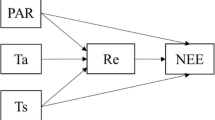Summary
A new model is proposed for the dispersion of animals and other organisms and its use is discussed for the analysis of the data from experiments on dispersion. The model is a generalisation of the random walk model, but because of its flexibility it should be much more widely applicable than the random walk model.
The new model has been found to fit the results of many dispersion experiments and examples are given of its use with data for millipedes and Drosophila.
Similar content being viewed by others
References
Burla, H., Da Cunha, A.B., Cavalcanti, A.G.L., Dobzhansky, Th., Pavan, C.: Population density and dispersal rates in Brazilian Drosophila willistoni. Ecol. 31, 393–404 (1950)
Dixon, W.J.: Biomedical computer programs. Berkeley: Univ. California Press 1973
Dobzhansky, Th., Wright, S.: Genetics of natural populations. X. Dispersion rates in Drosophila pseudoobscura. Genetics 28, 304–340 (1943)
Dobzhansky, Th., Wright, S.: Genetics of natural populations. XV. Rate of diffusion of a mutant gene through a population of Drosophila pseudoobscura. Genet. 32, 303–324 (1947)
Dobzhansky, Th., Powell, J.R.: Rates of dispersal of Drosophila pseudoobscura and its relatives. Proc. Roy. Soc. Lond. B187, 281–298 (1974)
Johnson, N.L., Kotz, S.: Continuous univariate distributions, Vol. 2. Boston: Mifflin 1970
Johnston, J.S., Heed, W.B.: Dispersal of Drosophila: the effect of baiting on the behaviour and distribution of natural populations. Amer. Nat. 109, 207–216 (1975)
Kendall, M.G., Stuart, A.: The advanced theory of statistics, Vol. 1. London: Griffin 1963
Manly, B.F.J.: The analysis of trapping records for birds trapped in mist nets. Biometrics 33, 404–410 (1977)
Mann, N.R., Schafer, R.E., Singpurwalla, N.D.: Method for statistical analysis of reliability and life data. New York: Wiley 1974
Pairman, E.: Tables of the digamma and trigamma functions. Tracts for computers, Vol. 1. London: Cambridge Univ. Press 1919
Placket, R.L.: The analysis of categorial data. London: Griffin 1974
Richardson, R.H.: Methods and analyses of dispersal patterns. In: Mathematical topics in population genetics (K. Kojima, ed.). Berlin-Heidelberg-New York: Springer 1970
Skellam, J.G.: Random dispersal in theoretical populations. Biometrika 38, 196–218 (1951a)
Skellam, J.G.: Gene dispersion in heterogeneous populations. Heredity 5, 433–435 (1951b)
Skellam, J.G.: The formulation and interpretation of mathematical models of diffusionary processes in population biology. In: The mathematical theory of the dynamics of biological populations (M.S. Bartlett, R.W. Hiorns, eds.). London: Academic Press 1973
Weibull, W.: Moments about smallest sample value. Tech. Rep. AFML-TR-67-375, Air Force Materials Laboratory, Wright Patterson Air Force Base, Ohio, USA (1967)
Wolfenbarger, D.O.: Factors Affecting Dispersal Distances of Small Organisms. New York: Exposition Press 1975
Author information
Authors and Affiliations
Rights and permissions
About this article
Cite this article
Manly, B.F.J. A model for dispersion experiments. Oecologia 31, 119–130 (1977). https://doi.org/10.1007/BF00348715
Received:
Issue Date:
DOI: https://doi.org/10.1007/BF00348715




